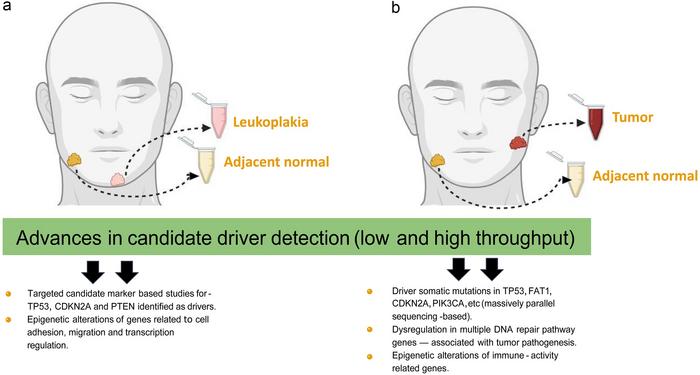Oral Leukoplakia (OLK) is recognized as a predominant potentially malignant oral epithelial lesion (PMOEL), posing significant risks due to its potential progression to oral squamous cell carcinoma (OSCC). OSCC, a major subset of head and neck cancers, accounts for a significant global health burden, especially in Asia. This review aims to explore the progression of OLK to OSCC, focusing on the roles of genetic and epigenomic alterations, and the implications of sample collection methods for research and diagnosis.

Credit: Bidyut Roy, Gourab Saha
Oral Leukoplakia (OLK) is recognized as a predominant potentially malignant oral epithelial lesion (PMOEL), posing significant risks due to its potential progression to oral squamous cell carcinoma (OSCC). OSCC, a major subset of head and neck cancers, accounts for a significant global health burden, especially in Asia. This review aims to explore the progression of OLK to OSCC, focusing on the roles of genetic and epigenomic alterations, and the implications of sample collection methods for research and diagnosis.
OSCC Overview
OSCC is the most common form of head and neck cancer, representing about 95% of such cases. It primarily affects the oral cavity and oropharynx, with a global incidence of over 350,000 new cases and approximately 177,000 deaths annually. PMOELs, such as leukoplakia, erythroplakia, and submucosal fibrosis, are critical to understanding the progression to OSCC. Although the majority of PMOELs do not advance to cancer, a significant portion of OSCC cases arise from these pre-existing lesions, underscoring the importance of early detection and monitoring.
Oral Leukoplakia (OLK)
OLK is characterized by white patches on the mucous membranes of the oral cavity. Histopathological examinations often reveal benign keratosis, hyperkeratosis, or hyperplasia, with a minority showing dysplasia. The risk of malignant transformation increases with the thickness of the lesion. Understanding the genetic and epigenetic changes within OLK is crucial for early intervention and prevention of progression to OSCC.
Tobacco Use and OLK
Tobacco use, both in smoked and smokeless forms, is a well-established risk factor for OLK and its progression to OSCC. The practice of reverse smoking, prevalent in certain cultures, significantly increases the risk of malignant transformation. The variability in transformation rates, ranging from 0.13% to 34%, can be attributed to diverse factors such as tobacco/alcohol habits, environmental conditions, and dietary practices.
Genetic Progression Model of Oral Cancer
The progression from OLK to OSCC involves a series of genetic alterations. Early stages are marked by changes such as allelic losses at 3p, 9p, and 17p, while later stages involve losses at 13q, 8p, and 18q. DNA aneuploidy and loss of heterozygosity (LOH) are critical markers of this progression. Studies have identified specific single nucleotide polymorphisms that modulate the risk of OLK and OSCC, highlighting the importance of genetic profiling in predicting cancer progression.
Epigenomic Alterations
Epigenomic changes play a pivotal role in the regulation of gene expression during the progression of OLK to OSCC. Studies in Indian cohorts have identified several epigenetically altered genes associated with patient survival and cancer progression. These alterations can provide insights into the mechanisms driving tumor development and potential therapeutic targets.
Sample Collection for Research
The collection of tissue samples from disparate patients and the same patients presents unique challenges and opportunities for research. Disparate patient samples often exhibit variations in tobacco and alcohol use, dietary habits, and environmental exposures, complicating the analysis. In contrast, samples from the same patients ensure consistency in exposure factors, providing a clearer understanding of the genetic and epigenetic changes involved in cancer progression. Recent advancements in single-cell transcriptomics offer deeper insights into the gene expression programs active in dysplastic and tumor cells, enhancing our understanding of OSCC initiation and progression.
Conclusions
Understanding the progression of OLK to OSCC requires a comprehensive approach that includes the study of genetic and epigenomic alterations, as well as meticulous sample collection methods. Advances in sequencing technologies and single-cell analyses are paving the way for more detailed and accurate models of cancer progression. Continued research in this area is crucial for developing effective strategies for early detection, prevention, and treatment of OSCC.
Full text
The study was recently published in the Cancer Screening and Prevention.
Cancer Screening and Prevention (CSP) publishes high-quality research and review articles related to cancer screening and prevention. It aims to provide a platform for studies that develop innovative and creative strategies and precise models for screening, early detection, and prevention of various cancers. Studies on the integration of precision cancer prevention multiomics where cancer screening, early detection and prevention regimens can precisely reflect the risk of cancer from dissected genomic and environmental parameters are particularly welcome.
Follow us on X: @xiahepublishing
Follow us on LinkedIn: Xia & He Publishing Inc.
Journal
Cancer Screening and Prevention
Article Title
Progression of Oral Leukoplakia to Cancer: Importance on Collection of Leukoplakia and Cancer Tissues from Disparate or Same Patients
Article Publication Date
25-Jun-2024



